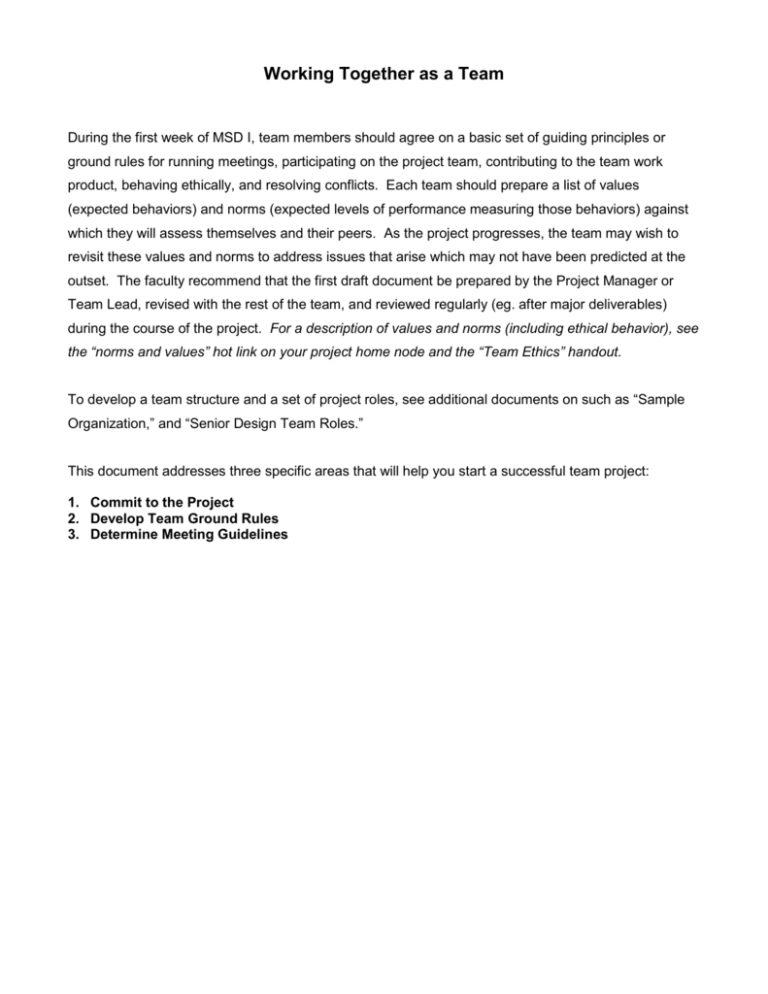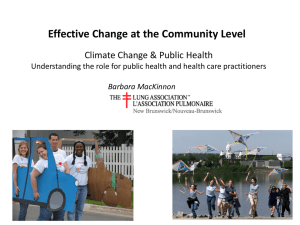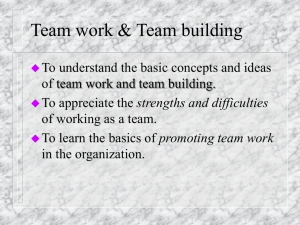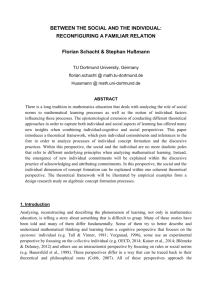Working Together as a Team
advertisement

Working Together as a Team During the first week of MSD I, team members should agree on a basic set of guiding principles or ground rules for running meetings, participating on the project team, contributing to the team work product, behaving ethically, and resolving conflicts. Each team should prepare a list of values (expected behaviors) and norms (expected levels of performance measuring those behaviors) against which they will assess themselves and their peers. As the project progresses, the team may wish to revisit these values and norms to address issues that arise which may not have been predicted at the outset. The faculty recommend that the first draft document be prepared by the Project Manager or Team Lead, revised with the rest of the team, and reviewed regularly (eg. after major deliverables) during the course of the project. For a description of values and norms (including ethical behavior), see the “norms and values” hot link on your project home node and the “Team Ethics” handout. To develop a team structure and a set of project roles, see additional documents on such as “Sample Organization,” and “Senior Design Team Roles.” This document addresses three specific areas that will help you start a successful team project: 1. Commit to the Project 2. Develop Team Ground Rules 3. Determine Meeting Guidelines 1. Commit to the Project Objective: To get agreement within the team on the level of commitment that each team member will be making to the project. Method: Discuss the commitments listed below. Add to, remove, or modify the items as appropriate for your team and the project. Only commit to do work that we are qualified and capable of doing. Be honest and realistic in reporting the progress of the project. Be proactive. Volunteer to an action before the Team Leader has to solicit it. Notify the Guide of any change to the project plan that may affect us. Follow through on our individual commitments to the team and accept responsibility for our actions. Keep other members informed of any potential problem that may affect the team’s performance. Focus on what is best for the project as a whole. See the project through the successful completion. Action: After everyone has agreed to the list of commitments, each team member should sign the list, indicating that he or she agrees to live by these commitments. 2. Develop Team Ground Rules Objective: To establish ground rules that will help team members recognize and use appropriate behavior, which will result in meetings that are more productive, open, and ultimately more fun. (See also the EDGE hotlink for “Team Norms and Values”). Method: Establish ground rules for team behavior. Consider meeting discussions confidential unless indicated otherwise. Listen openly to other people’s points of view. Encourage diverse opinions. Allow everyone the opportunity for participation. Keep discussions on track. Avoid placing blame when things go wrong. Instead, review the process and discuss how it could be improved. Agree on how team members will give and receive feedback Provide constructive feedback – don’t judge or label the other person but describe a specific behavior or incident. When you are receiving feedback: listen carefully and try to other points of view. When planning and solving Problems (technical and team processes): use data (when possible) or consensus. Don’t be a bully or be bullied. Understand the other person’s issue or problem. During Brainstorming sessions. (Brainstorming may be planned, such as Concept Development, or may be unplanned, as when trying to debug a project subsystem). o Encourage everyone to participate. o Never criticize ideas. o Think of ideas that are unusual or creative o Come up with as many ideas as possible in the time allowed. o Build on other team members’ ideas. 3. Determine Meeting Guidelines Objective. Agree on how team meetings will be structured and what procedures the team will use to keep meetings on track. Method: Agree on the basic structure for team meetings. Add to or modify the items listed below, according to team member suggestions. Meeting Structure Project meetings will be held every ________ (every Sunday, Tuesday, Friday) Meetings will be called by _______ (Team Lead or delegate) Agendas will be issued by ______ (list team members, may wish to rotate this) Guide’s Status Weekly Report will be issued by ______ (list team members, may wish to rotate this). Keep on EDGE Team Project so team members can review and update, as needed. Meetings will begin and end on time. The scribe will issue minutes within XX days of the meeting. The Team Leader will update Action Item List within XX days of the meeting. Meeting Procedures Team Leader may facilitate meetings or delegate this role to other team members. This may offer everyone experience and give the Team Leader a stress break! Follow the agenda and assigned times. Add unresolved issues to an “issues list” at every team meeting. For each issue, assign someone to the resolve it and set a target date or completion. As with the facilitation role, the team may decide to rotate other meetings tasks. You may have experienced this during one of your co-op quarters. Propose topics or items to include on the agenda for the next meeting. Evaluate each Team Meeting. Did we meet our objectives? Did we follow our own guidelines? Did we follow the agenda? Use data and consensus-based decision making in team meetings. Ask your Guide for tools, if necessary.







